Recent Articles
Popular Makes
Body Types
2020 Ford Ranger Level 3 Road Test and Review
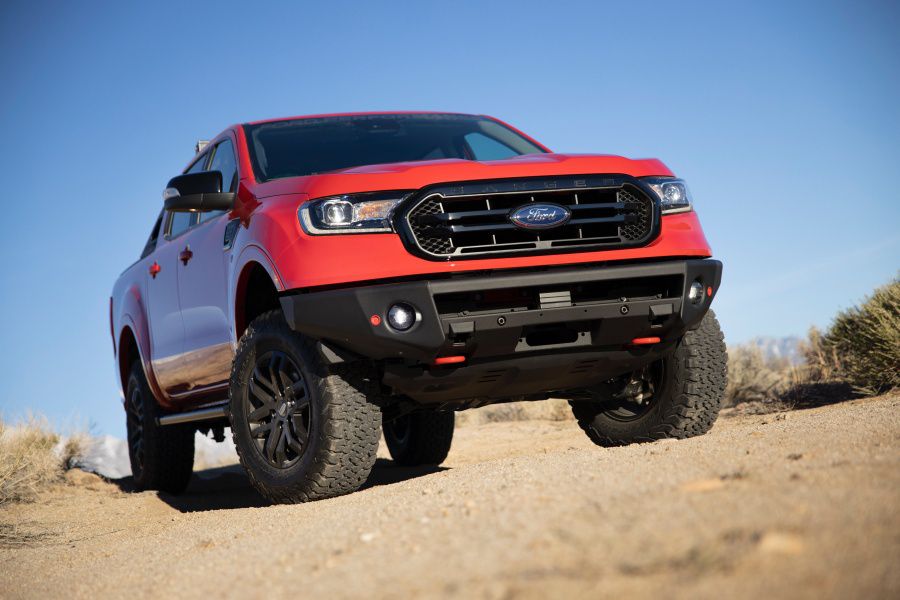
2020 Ford Ranger Performance Level 3 ・ Photo by Ford
As we were testing the new 2020 Ford Ranger Level 3, the most off-road-capable version of the mid-size pickup, Ford’s new 2021 Bronco SUV was breaking the Internet. So along with the new 2021 Ram 1500 TRX, which is that brand’s most powerful and off-road-ready pickup ever, off-road trucks are hot right now.
Ranger is Ford’s smallest pickup. It’s built in Michigan and was introduced just last year. This year, Ford Performance has introduced three special off-road packages for buyers interested in hitting the trail. They add off-road capability and a considerable amount of rugged styling. The Level 3 package worn by our Race Red test vehicle is the most serious, and it takes just a few feet of rugged trail to realize the 2020 Ford Ranger Level 3 is a very capable rig. It competes with the Toyota Tacoma TRD Pro, Chevrolet Colorado ZR2, Jeep Gladiator Mojave and Rubicon, GMC Canyon All Terrain, and Nissan Frontier Pro-4X.
Three Levels of Performance
According to Ford, Ranger owners added an average of about $650 worth of accessories to their trucks last year. The automaker wants a piece of that action. “Our goal is to inspire customers by giving them capabilities and styling options from the aftermarket brands they love,” said Eric Cin, global director, Ford Vehicle Personalization.
These three new off road packages — cleverly called Level 1, Level 2, and Level 3 — can be installed by Ford dealers and bolt onto any 2019 and 2020 Ranger with four-wheel drive. All three feature an off-road leveling kit with FOX Shocks, the same company that supplies the shocks used on the Ford Raptor, new 17-inch Dyno Gray wheels, and Ford Performance graphics on the bed and windshield. The Level 2 and Level 3 Packages also add bigger tires as well as considerable horsepower and torque to the Ranger’s turbocharged four-cylinder engine.
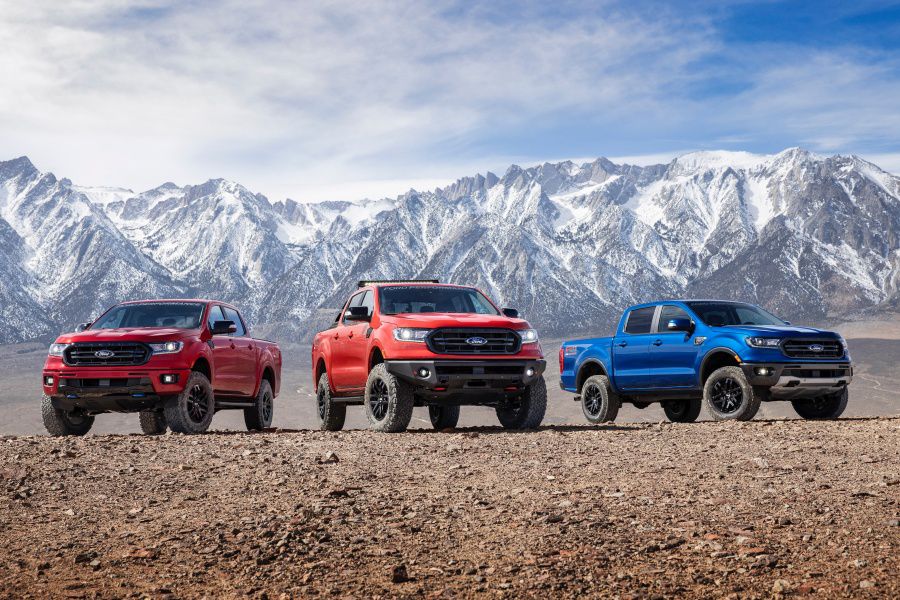
Photo by Ford
List of Goodies and Pricing
Here’s the list of goodies and the pricing, but know that the prices don’t include the cost of installation. Level 1 and Level 2 packages are available now, while the Level 3 package will be available in summer 2021.
The Ford Performance Level 1 package costs $2,495 plus installation and includes an off-road leveling kit that raises the front end about 2 inches; FOX 2.0 Performance Series front and rear shocks; and Ford Performance 17-inch Dyno Gray wheels, bedside graphics, and windshield banner. The Level 2 package costs $4,495 plus installation and includes the Level 1 content plus an engine recalibration that increases horsepower 16 percent to 315 at 4,500 rpm and torque nearly 20 percent to 370 lb-ft at 2,500 rpm; BFGoodrich KO2 265/70-17 tires; a rigid off-road fog light kit; blue tow hooks; and a Ford Performance stainless steel license plate frame. The Level 3 will cost $8,995 plus installation, and it adds a rigid 40-inch LED lightbar; red tow hooks; a Steel Ford Performance by ARB winch-capable front bumper; a Ford Performance chase rack; and a sport exhaust system.
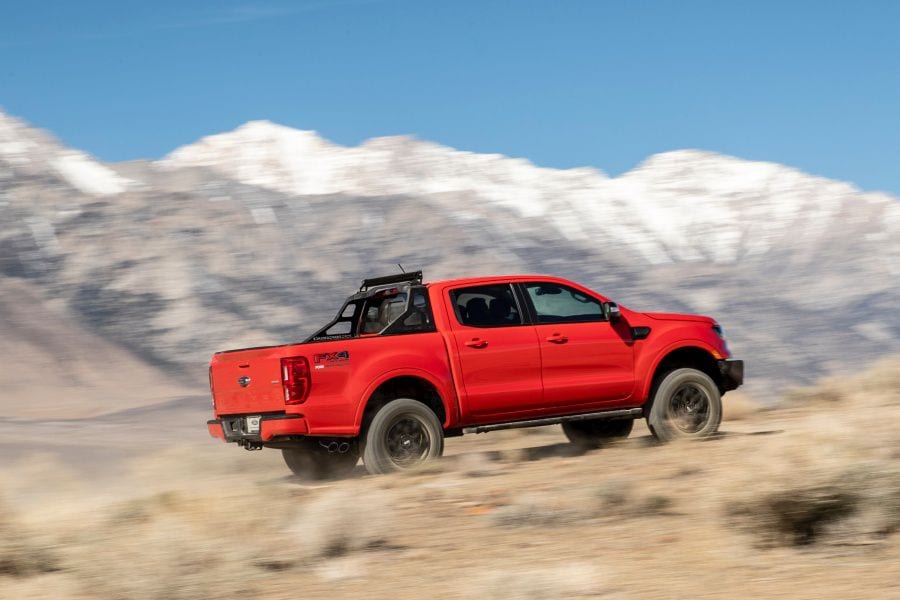
Photo by Ford
Well Over 300 Horsepower
Unlike its competitors, which all offer V6 engines, every Ford Ranger is powered by a smooth and powerful 2.3-liter turbocharged four-cylinder mated to an excellent 10-speed automatic transmission. It puts out 270 horsepower at 5,500 rpm and 310 lb-ft of torque at 3,000 rpm. It’s plenty, but some of its rivals offer standard engines with over 300 hp.
With the Level 2 and Level 3 packages, those numbers jump to 315 horsepower at 4,500 and 370 lb-ft at 2,500 rpm. Those are big numbers for this class. And notice the engine now makes its power at lower engine speeds, which improves acceleration and its response off road. Surprisingly, Ford says the Rangers fuel economy estimates are unaffected by the additional power achieved by retuning the engine management system. With four-wheel drive, those estimates are 20 mpg in the city and 24 mpg on the highway, which is high for this class. We averaged 20 mpg in mixed driving, which included our off-road testing, and we used its start/stop feature religiously.
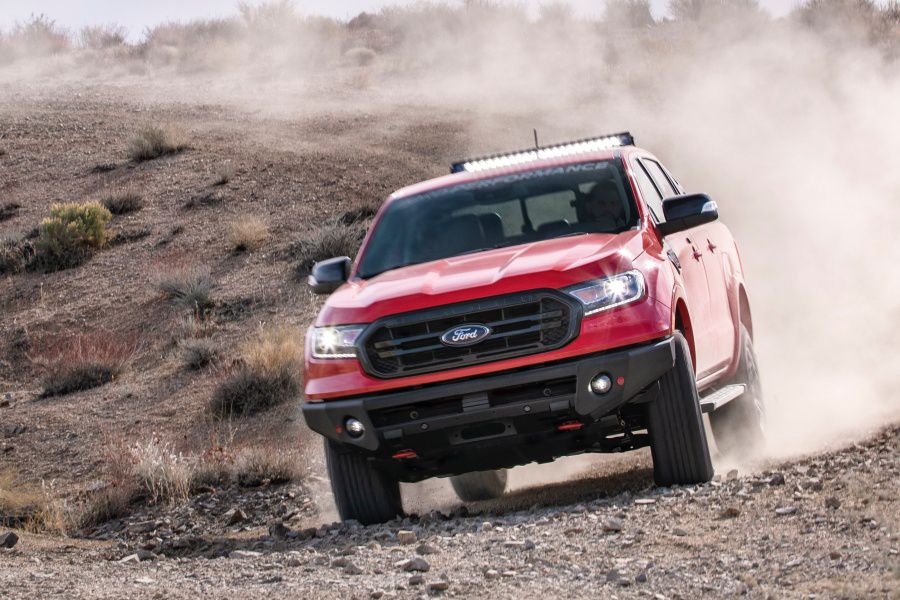
Photo by Ford
Firm On-Road Ride
In the city, the ride of the Ranger Level 3 is firmer than a typical Ranger. It’s not too rough by any means, but it’s not as cushy as the larger and heavier Ford Raptor, either. Some extra bounce is to be expected from its larger tires and special shocks, which do an incredible job controlling body motions, but it’s not quite as comfortable as the ride of its rivals, including the Tacoma TRD Pro and the Mojave and Rubicon versions of the Jeep Gladiator.
Thanks to its extra torque, the Ranger Level 3 is never short on power. It’s quick off the line and its responsive 10-speed is always ready with a downshift on the highway. In some very low-speed situations, there is some turbo lag, but that’s more of an issue off road than it is in the city. The Ford Performance sport exhaust included in the Level 3 Package doesn’t sound great, but it doesn’t drone on the highway like the exhaust of the Toyota Tacoma TRD Pro.
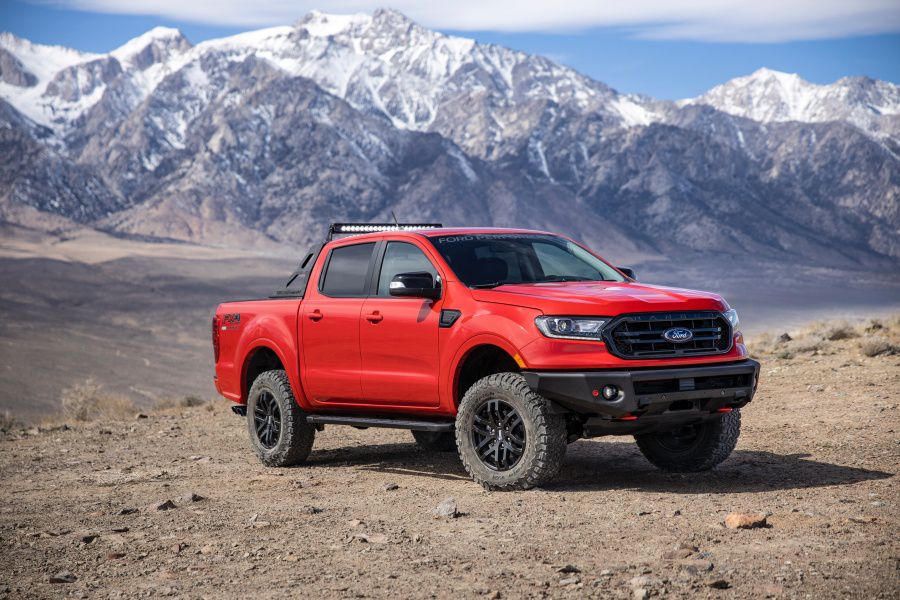
Photo by Ford
Awesome Off-Road Ability
Off the paved road, the increased suspension control is very noticeable, especially up front. The Ranger Level 3 can scramble effortlessly up and over some surprising rough terrain in 2WD, even more with its rear axle locked. Every Ranger equipped with the FX4 Off Road Package has a locking rear axle, which is engaged with a button on the truck’s console; a steel front skid plate; and underbody protection. The package also includes Ford's Terrain Management System with settings for grass, gravel/snow, mud/ruts, and sand, plus an off-road display that gives you pitch, roll, and steering-angle readouts.
But Ford doesn’t offer a locking front differential, which is standard on the Chevy Colorado ZR2 and the Jeep Gladiator Rubicon. The Ford proved to have plenty ground clearance as we tackled a few rocky trails we’ve avoided in other trucks, and in low range, with its rear axle locked, it climbed like a mountain goat. It also excelled on some higher-speed dirt roads, over mild whoops and dips.
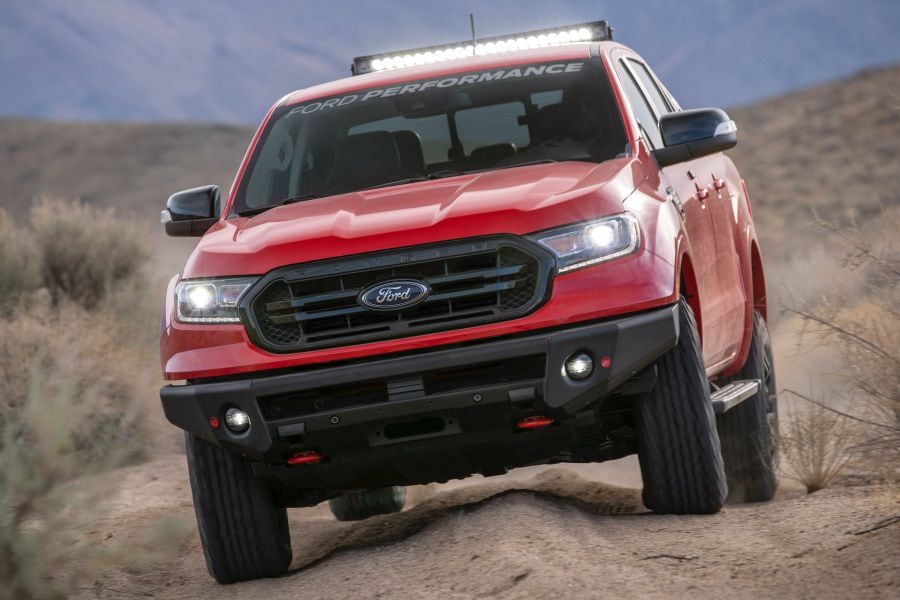
Photo by Ford
Good Cargo and Towing Capability
Perhaps most importantly, these Ford Performance packages don’t compromise the Ranger’s other capabilities. The changes to its suspension don’t change the truck’s maximum payload or tow ratings. With 4WD the Ford is rated to haul between 1,560 lbs and 1,860 lbs depending on its body style, and every Ranger can tow 7,500 lbs.
Those are good numbers for this class. Chevy’s Colorado ZR2 with either engine can only carry 1,100 lbs and tow 5,000 pounds. And the Toyota Tacoma TRD Pro has a payload rating of 1,155 lbs and can tow only 3,500 lbs. Heck, even Ford’s big burly Raptor is only rated to haul about 1,200 lbs. Our test truck was also equipped with a spray in bedliner, but we were disappointed by its lack of bed lighting and tie-down hooks. Also, its tailgate isn’t damped. It should be.
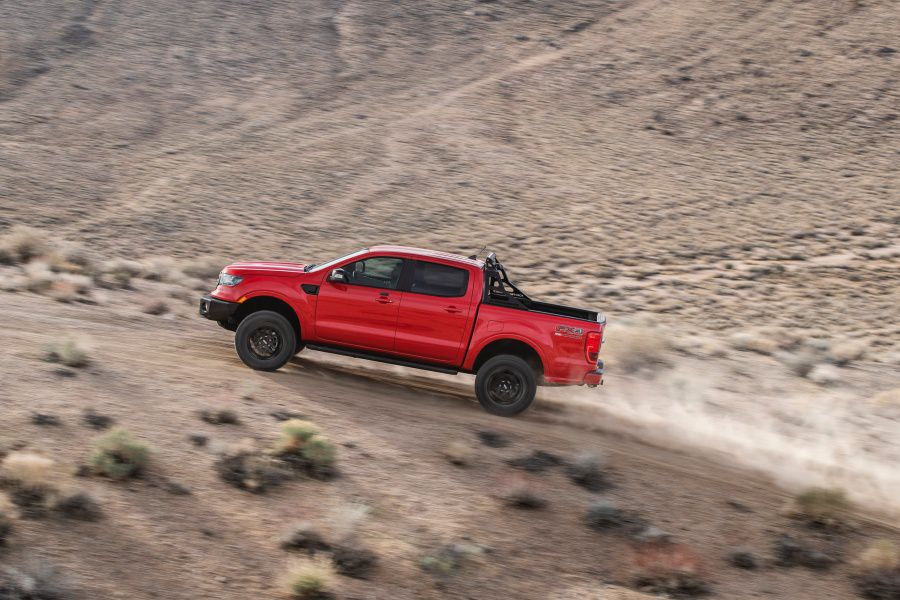
Photo by Ford
Level 3 Looks Tough
Ford’s Ranger is an attractive truck, but the Level 3 is just cool. Its reshaped steel front bumper — which was designed by ARB, a legendary off-road parts company — not only adds clearance and strength, but it looks like a battering ram. It also cleanly integrates parking sensors, which come in handy in the mall parking lot and out on the trail.
The truck’s chase rack, which is bolted to the top of its bed, gives the rig a Baja 1000 vibe and its Rigid 40-inch LED lightbar pumps out enough candlepower to light the darkside of the moon. It’s just the ticket for some night wheeling. I also really like the Ranger’s stance. The Level 3’s unique 17-inch wheels look like they came from the aftermarket, and its BFGoodrich KO2 265/70-17 tires are packing plenty of beef. The Level 3 doesn’t look quite as serious as a Colorado ZR2, which also has bulging fenders and hood, but it looks tougher than a Tacoma TRD Pro. Hardcore truck dudes know it’s special and give you the thumbs-up when you drive by.
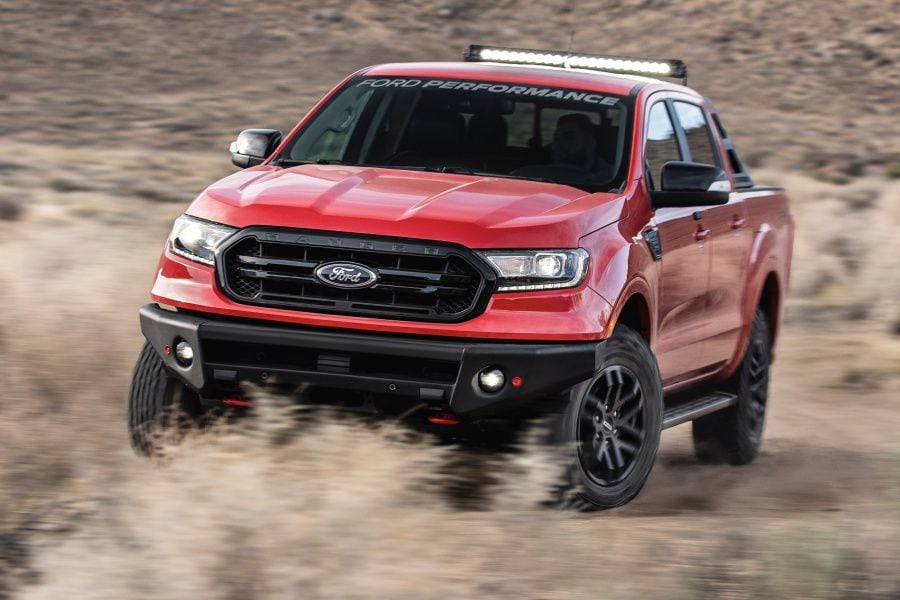
Photo by Ford
Luxurious Interior
Our test truck was the Ranger’s top trim level, Lariat, and it packed our vehicle with a long list of luxury items. Its interior featured very comfortable leather seats with power adjustment and heat, onboard 4G LTE Wi-Fi, remote keyless entry, and an 8-inch touchscreen with navigation. The Ranger’s interior is also packed with quality materials, precise fits and finishes, and a design worthy of your greenbacks. There’s plenty of interior storage and charge points, but Ford should find a way to include some storage under the rear seat.
Also standard on the Lariat are a considerable list of accident avoidance systems and driver aids including automatic emergency braking and a blind-spot warning system. Unfortunately, the Ranger’s overall safety score isn’t as high as it can be. The National Highway Traffic Safety Administration rates it four out of five stars.
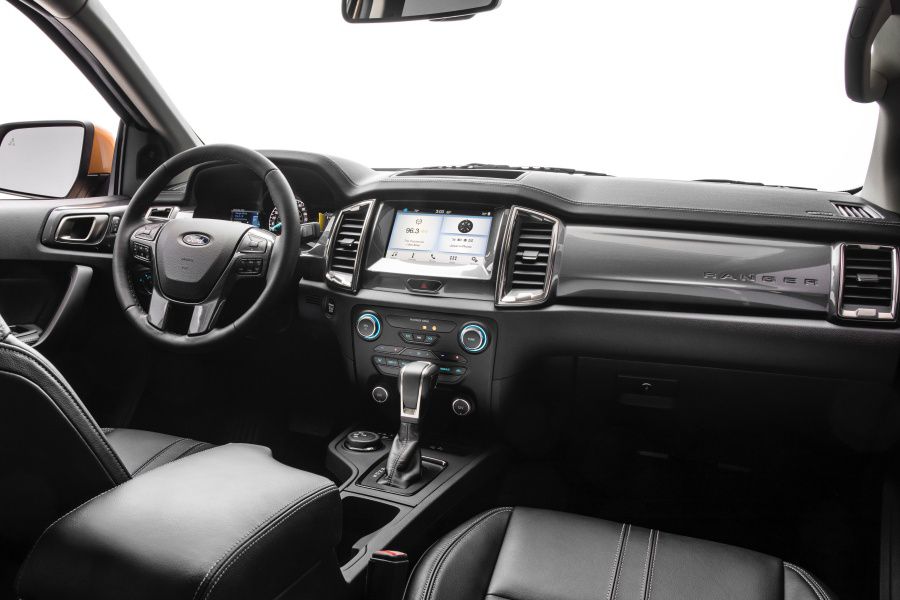
Photo by Ford
Final Thoughts
Ford’s engineers have done an excellent job with the Ranger Level 3. It’s not only exceedingly capable off road, but it’s comfortable enough in the city, and its power and fuel efficiency are strong for it class. It also looks great, with just the right amount of attitude.
It is expensive, however; our loaded test truck cost $55,905. That price includes a $1,195 destination fee, but it doesn’t include the installation cost of the Level 3 parts. Ford’s larger F-150 Raptor has more wheel travel to work with and handles rough terrain better, but the Ranger is much narrower, meaning it can fit down tight trails the Raptor cannot. If you’re shopping for an extremely capable mid-size off-road rig with plenty of image, the new 2020 Ford Ranger Level 3 is worth a look.
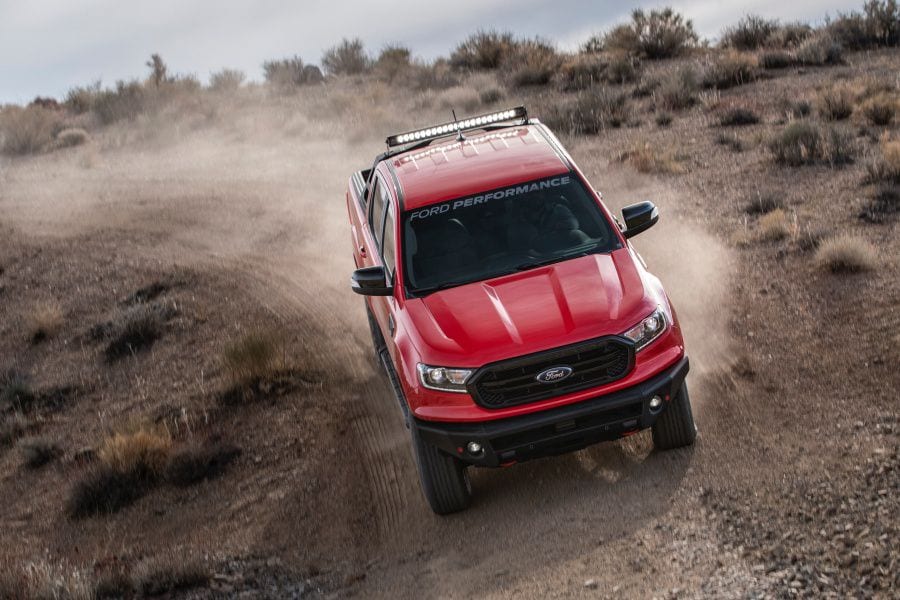
Photo by Ford